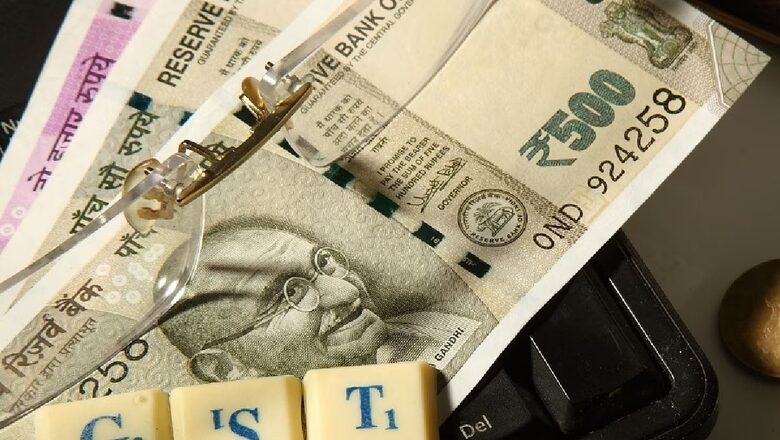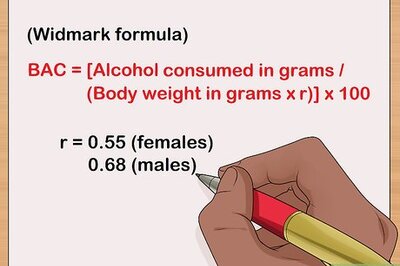
views
Goods & Services Tax (GST) collections during the month of May 2024 came in at Rs 1.73 lakh crore, recording a growth of 10 per cent year-on-year. For the previous month (April 2024), GST collection had hit a record of Rs 2.10 lakh crore, up 12.4 per cent year-on-year. Clearly, GST has been a mega success, showcasing how Modinomics has combined grand vision with seamless execution, made possible by Prime Minister Narendra Modi’s incisive foresight. The fiscal year 2023-24 (FY24) marked a significant milestone with total gross GST collections surpassing Rs 20 lakh crore, reflecting an 11.7 per cent increase over the previous fiscal year. This resulted in an average monthly collection of approximately Rs 1.68 lakh crore in FY24.
The 53rd GST Council meeting introduced pivotal reforms to streamline the GST framework, reduce litigation, and ease the financial burden on businesses. The quantum of pre-deposit required for filing appeals under GST has been significantly reduced, easing the financial burden on taxpayers. No interest will be levied on the amount available in the Electronic Cash Ledger on the due date of filing a return if there is a delay, offering further financial relief to businesses. The Council recommended introducing a sunset clause from April 1, 2025, for receiving any new applications for anti-profiteering. This long-awaited change will allow businesses to operate normally, with the competitive economy naturally managing pricing details.
To reduce litigation, the 53rd Council set monetary limits for filing appeals by the Department: Rs 20 lakh for the GST Appellate Tribunal, Rs 1 crore for the high court, and Rs 2 crore for the Supreme Court. This initiative aims to focus judicial resources on cases with substantial tax implications, promoting efficiency and ensuring faster resolution of disputes. The deadline for availing ITC for invoices or debit notes under Section 16(4) of the CGST Act for the fiscal years 2017-18, 2018-19, 2019-20, and 2020-21 has been extended to November 30 of the following year to provide relief to taxpayers.
The Council recommended waiving interest and penalties for demand notices issued under Section 73 of the Central Goods and Services Tax (CGST) Act, covering cases not involving fraud or willful misstatement, for the fiscal years 2017-18, 2018-19, and 2019-20. This waiver applies if the full tax demanded is paid by March 31, 2025. Interest and penalty waiver for tax demands paid under notices issued under Section 73 is a very pleasing announcement and would go a long way in curtailing unwarranted litigations under GST.
Adjustments to GST rates on various goods were recommended, including a uniform 5 per cent IGST on aircraft parts and a 12 per cent GST on milk cans, solar cookers, and certain paper products. Exemptions were proposed for certain services provided by Indian Railways and accommodation services benefiting students and professionals.
The 53rd Council recommended rolling out biometric-based Aadhaar authentication for registration applicants on a pan-India basis in phases. This would help weed out fake registrations and fake credits, effectively reducing fraud. New mechanisms for claiming refunds, adjustments in pre-deposits for appeals, and relaxed conditions for ITC claims were among the recommendations aimed at facilitating trade. Clarifications were provided on various tax-related issues, including the valuation of supply services, the applicability of ITC, and the place of supply for specific services. The decisions taken at the 53rd GST Council meeting reflect a concerted effort to address industry concerns and facilitate easier compliance, marking a significant step forward in India’s tax administration.
July 1, 2024, will mark the 7th anniversary of the Modi government’s landmark indirect tax reform, the Goods and Services Tax (GST), which is based on the premise of ‘One Nation One Tax’, which makes India a unified, common market. It is a single, destination-based, multi-stage tax on the supply of goods and services, right from the manufacturing to the consumption stage. Credits of input taxes paid at each stage are available in the subsequent stage of value addition, which makes the GST, essentially a tax only on value addition at each stage. It is indeed the Input Tax Credit (ITC), besides a whole host of other progressive moves, which make the GST, as we know it in India, superior to any other consumption-based or Value Added Tax (VAT) in any other country in the world.
There is no single kosher indirect tax or GST rate worldwide. In fact, there are over 40 different GST structures in 160-odd countries where it is applicable. Hence, those who have been alleging that India’s GST is a multi-tier one and therefore inefficient, are absolutely ignorant. Indian variation of GST is unique due to the sheer array of numbers involving a country of over 1.4 billion people. Before GST, tax rates ranged from 28 per cent to 31 per cent, with entertainment tax as high as 110 per cent. After the Modi government’s groundbreaking implementation of GST, the tax rate on 1,186 commonly used goods (nearly all of the 1,214 widely used goods) is now well below 18 per cent. That clearly has to be the biggest pro-middle-class friendly move ever, by any government in post-independent India.
In fact, when GST was introduced in July 2017, after taking the Opposition into confidence, the idea was to have a revenue-neutral rate (RNR) of 15.5 per cent within 2-3 years hence. However, the RNR today stands at a mere 11.4 per cent, demonstrating that the Modi government is actually taxing at a far lower rate than initially planned. Despite supply chain disruptions arising from Covid-19 and the Russia-Ukraine conflict, the government has chosen to strike the right balance between tax base and tax rates in the post-Covid era and the low RNR reflects precisely that. Remember, compared to the current 11.4 per cent RNR, the comparable tax rate under the inept Congress exceeded 20 per cent. When PM Modi took office in May 2014, over 226 items were slapped with taxes over 28 per cent, with some facing effective rates as high as 33 to 40 per cent! Today, a mere 28 items attract a 28 per cent tax rate, primarily those considered Sin goods: tobacco, aerated drinks, high-end sedans, etc. So, without a doubt, overall tax rates under the Modi government in the last 10 years have come down drastically, with GST in the last 7 years epitomising progressive taxation.
GST has demonstrably benefited the poor and middle class. Numerous essential goods are either entirely exempt from GST or taxed at a minimal 5 per cent. This includes sanitary pads, which previously faced a 13.5 per cent tax but are now tax-free. Travel and entertainment have also seen significant GST reductions. Religious tourism now enjoys a reduced 5 per cent rate, while economy class air travel is taxed at 5 per cent and business class at 12 per cent. Movie tickets costing up to Rs 100 saw their GST lowered from 18 per cent to 12 per cent, and those above Rs 100 went from 28 per cent to 18 per cent. Furthermore, GST on everyday necessities like tyres, auto parts, and TVs up to 32 inches was reduced from 28 per cent to 18 per cent. By implementing these lower rates, the GST system has proven to be carefully calibrated to support lower- and middle-income households while simultaneously maintaining revenue generation. This approach to taxation fosters both economic participation and social equity.
No country with India’s geographical size, complexity or population could have reined in inflation amidst a choppy global environment and still effectively executed GST, but the Modi government did that with panache and much more. In effect, of the 160-odd countries that have adopted GST, only 49 follow one tax slab module, 28 countries have two slab tax modules and the rest have modified and tweaked the GST structure to align it to their country-specific needs, which essentially means there is no need to follow the “all size fits one” approach.
The seamless implementation of GST by the Modi government stands as a glowing testament to the power of bold leadership and unwavering political will. This monumental achievement has unified India’s indirect tax system, subsuming a complex web of previous taxes including:
- Central excise duty
- Additional excise duty
- Service tax
- Additional duty of customs (equivalent to excise)
- State VAT
- Entertainment tax
- Taxes on lotteries, betting, and gambling
- Entry tax (not levied by local bodies)
- Octroi
- Luxury tax
This bold move has swept away a cumbersome and often confusing system, replacing it with a single, unified indirect tax structure for the nation.
An e-Way bill, which is an electronic permit for shipping goods, similar to a waybill, is now mandatory for inter-state transport of goods effective from April 1, 2018, under the GST regime. It is required to be generated for every interstate movement of goods beyond 10 kilometres, with the threshold limit being Rs 50, 000. It is a paperless technology solution and a critical anti-evasion tool to check tax leakages and clamp down on trade that happens on a cash basis, beyond a certain limit. Along with GST, the e-Way bill, with RFID tags for motor vehicles which are captured at toll plazas by sensors, have been gigantic steps in the right direction in improving tax compliance. On average, today, over 95 million e-Way bills are generated every month, showcasing economic vibrancy.
Rahul Gandhi and his coterie of sycophants can wallow in their false bravado and desperation, lamenting what they could have done with GST. But an idea is worthless without implementation. While the Congress wasted almost ten years building castles in the air with the Kelkar committee recommendations, the Modi government deserves kudos for walking the talk. They tackled thorny issues head-on, made necessary alterations, and ultimately brought GST to life on July 1, 2017. Consider the facts: close to Rs 10,000 crore is paid to states every month as a revenue deficit grant (RDG). Last year alone, over Rs 2 lakh crore went to states as GST compensation, with Kerala and West Bengal receiving a significant share. The allegations that the Modi government is depriving states of compensation are utterly baseless.
It is time for the Congress to stop playing the ‘martyr’, and churlishly blaming the BJP for ‘snatching’ their idea, which never was their idea in any case, to start with. In a democracy, an idea is worth its weight in gold only if executed effectively. The Modi government reduced GST on under-construction houses from 12 per cent to 5 per cent, and in the ‘affordable housing’ segment, it was reduced from 8 per cent to a mere 1 per cent, once again endorsing the pro-people approach of the BJP-led NDA government. A house with a carpet area of 60 square metres costing up to Rs 45 lakh in a metro city and a house with a carpet area of 90 square metres costing up to Rs 45 lakh in a non-metro, would be designated as “affordable”.
India’s post-GST fuel economy has become more competitive, thanks in part to the elimination of octroi and entry taxes at interstate checkposts. Truckers previously faced endless waits at these checkpoints, significantly hindering their efficiency. Now, they can cover 325-350 km in a day, a marked improvement over the 200-225 km they averaged before GST. This increased efficiency is largely due to the reduced number of stops at toll booths. The GST Council has also implemented several consumer-friendly rate reductions. In November 2017, it lowered GST for all AC and non-AC restaurants from 18 per cent to a more affordable 5 per cent. Only starred restaurants with tariffs exceeding Rs. 7,500 were exempt from this reduction. This move stands in stark contrast to the previous system, where a combination of service tax, surcharge, cess, and other taxes could add a hefty 28-33 per cent to dining bills. Furthermore, in December 2018, the GST Council made services rendered to all Jan Dhan accounts in the country entirely tax-exempt. This decision exemplifies the Modi government’s commitment to inclusive development, proving that “Sabka Saath, Sabka Vikas, Sabka Vishwas” is not just a slogan but a guiding principle.
To curb corruption, tax leakages and frauds using fake invoices, the Modi government brought in e-invoicing in 2020, for those with more than Rs 500 crore turnover. The Rs 500-crore threshold was then brought down to Rs 100 crore and subsequently Rs 50 crore and now it is applicable for those with annual turnover of over Rs 5 crore. By next year, it may be further reduced, thereby putting an end to the mismatching of invoices that in turn leads to delayed reconciliation of accounts.
The pre-GST era burdened businesses with a staggering 495 different forms. In stark contrast, the post-GST era requires only a handful – a mere 12 forms. Here’s a quick rundown of the key GST return forms:
- GSTR-1: This monthly return details all outward supplies made by a registered dealer/person.
- GSTR-2: This purchase return covers all inward supplies received by a registered dealer/person.
- GSTR-3B: The Government of India introduced this consolidated summary return to ease the transition to GST for businesses. It provides a summarised overview of inward and outward supplies.
Additionally, Rule 80 of the CGST Rules 2017 outlines different return types under the GSTR-9 form:
- GSTR-9A: For taxpayers under the Composition Scheme.
- GSTR-9B: Specifically for Electronic Commerce (e-comm) Operators.
- GSTR-9C: Required for businesses obligated to have their accounts audited according to Section 35 of the CGST Act.
The GST structure chooses to tax demerit goods at the highest rate to disincentivise “sin goods”, while keeping tax rates for items of mass consumption at zero or 5 per cent. The GST model, under the Modi government, strikes just the right balance between the tax base and tax rates, thereby preventing the tax structure from becoming regressive.
The GST Council is a truly federal body with representatives from every state government, including Union Territories with Legislatures, with the Central government represented by the Union finance minister, who is the chairperson of the Council. The voting structure of the GST Council is such that states together have a two-thirds weightage of the vote. The Centre has a one-third weightage of the vote. In other words, the overwhelming majority of decisions taken by the GST Council have been through unanimous consensus of the states and the Centre. The most recent rate rationalisations recommended by the GST Council following its 47th meeting were on the basis of recommendations of the Group of Ministers (GoM) on rate rationalisation. There were reports two years back that the decision of the GST Council to impose a GST of 5 per cent on pre-packaged and pre-labelled retail packs of certain food items happened for the first time ever. This is again not true. These items were taxed in the pre-GST, VAT era as well.
Notably, 11 food items are entirely exempt from GST when sold loose. This exemption covers staples like pulses/daal, wheat, rye, oats, maize, rice, atta/flour, suji, besan, puffed rice, and curd/lassi. Were these food articles being taxed for the first time? No. States already generated substantial revenue from food grains before GST. For instance, Punjab alone collected over Rs 2,000 crore annually through purchase tax on food grains. In fact, the post-GST era has brought significant overall tax relief to the middle class. Take, for example, everyday essentials like shampoos, soaps, detergents, toothpaste, and sanitary ware. These previously faced a hefty 30 per cent tax, which has now been reduced to 18 per cent under GST — a substantial 40 per cent decrease.
The best thing about GST is that there are no hidden taxes. What you see is what you get. Efficiency gains, higher compliance, prevention of tax leakages, lower rates, wider base, export friendliness and tax neutrality have brought down the overall tax burden for the middle class and enhanced the ease of doing business, especially for small industry bodies. ‘One Nation, One Tax’ embodied by GST is the single biggest indirect tax reform in India’s economic landscape, made possible by the conviction of Prime Minister Narendra Modi and it is truly creating a unified and integrated market in more ways than one.
The 53rd GST Council’s recommendations under Modi 3.0 include waiving interest and penalties for certain tax demands, extending Input Tax Credit (ITC) deadlines, reducing pre-deposit requirements for appeals, and implementing a sunset clause for anti-profiteering provisions. These proposed measures reflect a continued effort to streamline the GST system and enhance its efficacy for both taxpayers and the administration, paving the way for a more efficient and business-friendly tax environment in India.
The Modi government’s pro-business and pro-people GST is poised to simplify compliance, reduce litigation, and alleviate the financial burden for businesses and masses, marking a significant step towards improving the ease of doing business and ease of living in the country.
Sanju Verma is an Economist, National Spokesperson of the BJP and the Bestselling Author of ‘The Modi Gambit’. Views expressed in the above piece are personal and solely those of the author. They do not necessarily reflect News18’s views.















Comments
0 comment